Intel’s Sandy Bridge i7-2820QM: Upheaval in the Mobile Landscape
by Jarred Walton on January 3, 2011 12:00 AM EST- Posted in
- Laptops
- Intel
- Sandy Bridge
- Compal
Sandy Bridge Graphics: Extended Compatibility and Performance Results
It’s been quite a while since we last looked at gaming compatibility and performance on a large group of titles, so we figured the timing was ripe with the Sandy Bridge launch. We went through and selected fourteen additional games from the past several years; the intention is to see if SNB can run the games properly, as well as what sort of performance it can provide.
For comparison, we selected four other notebooks that we had on hand, which we’ve already highlighted on the previous page. Dell’s Latitude E6410 represents the old guard Intel HD Graphics, and the Toshiba A660D (forced onto the integrated HD 4250 GPU) is AMD’s soon-to-be-replaced IGP. Both are slower than SNB by a large amount, as we’ve already established. On the higher performance side of the equation, we’ve again got the Acer 5551G with a Turion II P520 (2.3GHz dual-core) processor and HD 5650 GPU, and for NVIDIA we have the ASUS N53JF with i5-460M and GT 425M. We tested Low and Medium detail performance, again skipping the Dell and Toshiba systems for Medium.
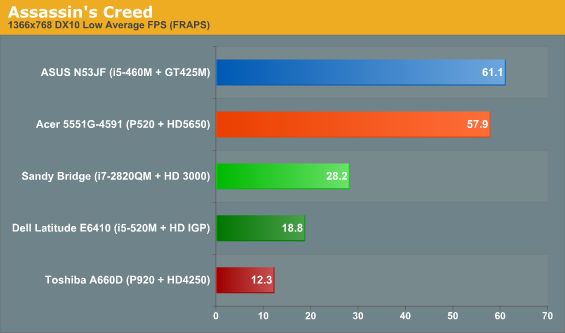

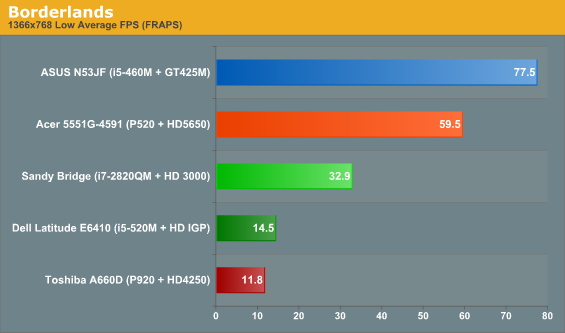
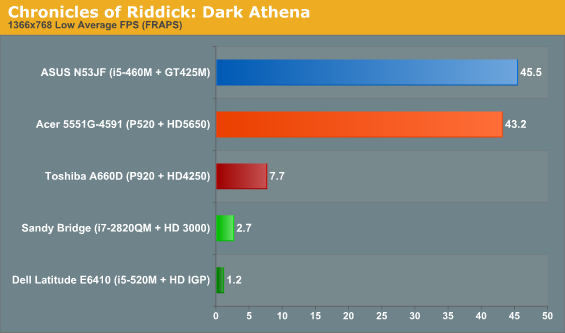

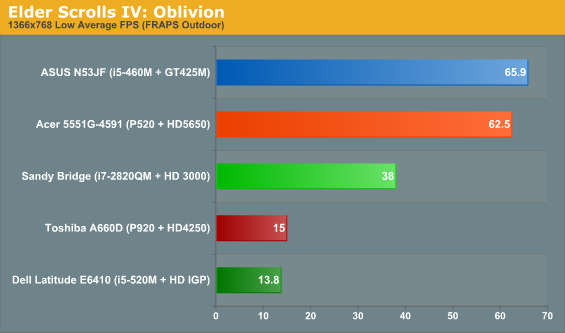
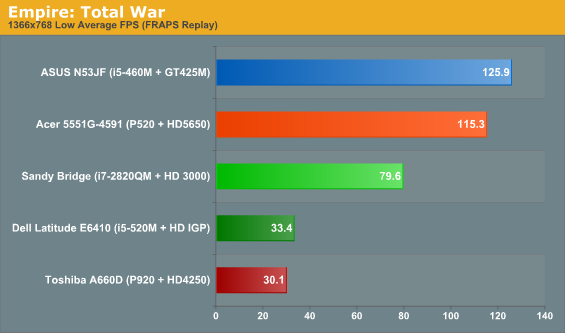
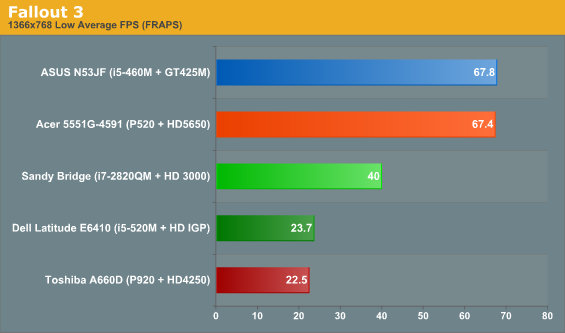
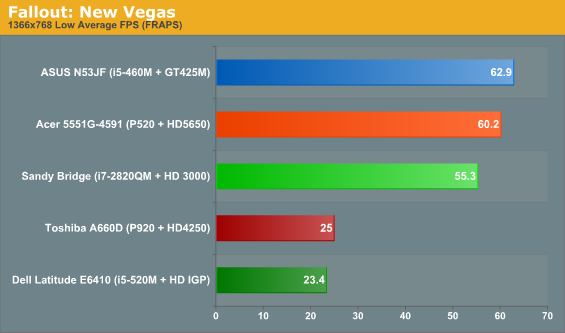
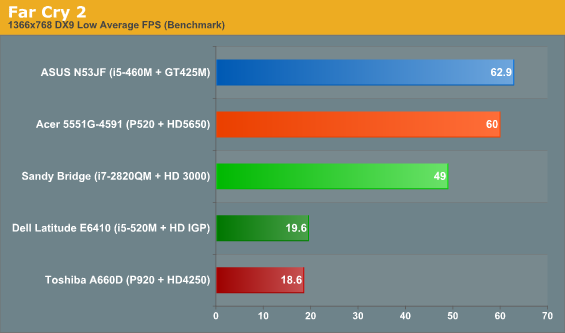
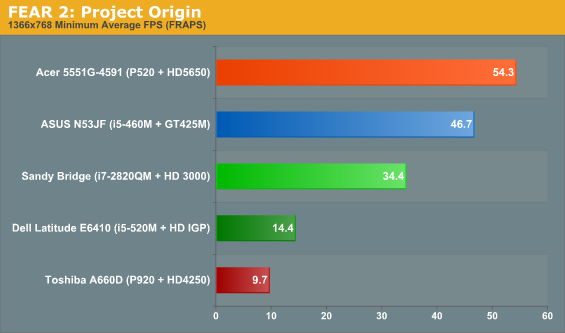

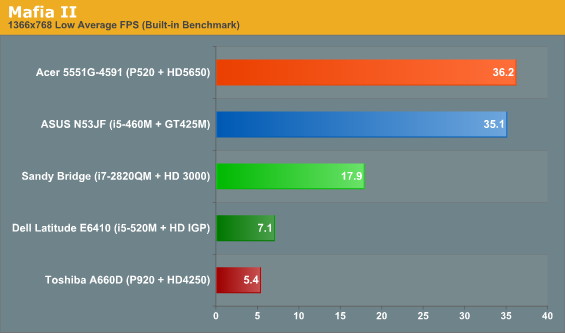
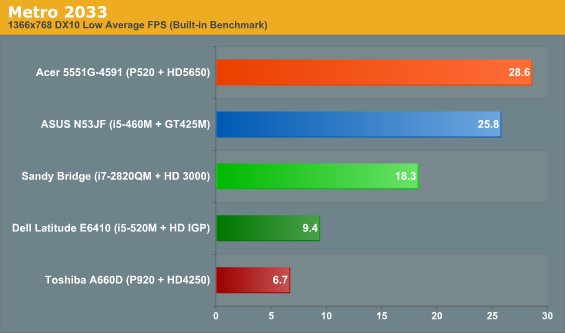
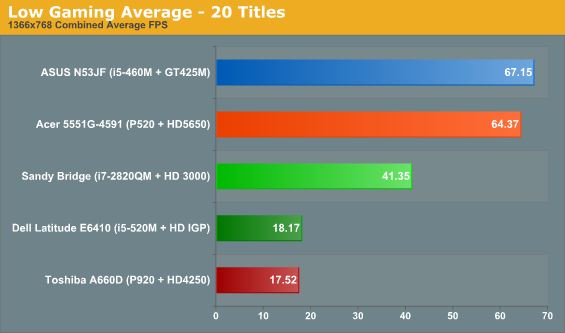
Adding 14 additional titles to the mix exposes a few more areas where Intel’s HD Graphics 3000 chip needs some fine tuning, but again all titles managed to at least run (with a bit of elbow grease). The problem areas run the range of blacklisted titles to minor rendering flaws (sometimes major flaws on older Intel graphics), with one title running but doing so poorly that it may as well have failed the test.
Going into details, first up is the now-infamous Fallout 3, which required a hacked D3D9.dll file to even run (just put the file in the game’s directory—thanks to the creators at OldBlivion). The hacked DLL identifies Intel graphics as a GeForce 7900 GS; without the DLL, the game crashes to the desktop with an error message as soon as you try to enter the actual game world. (Also note that the newer Fallout: New Vegas has no such problems, so Ubisoft was kind enough to stop blacklisting Intel’s IGPs it appears.) There are almost certainly other titles where the Intel IGP is blacklisted, and more than a few games warned of an unknown GPU and potential rendering problems (HAWX 2, Mass Effect 2 and Metro 2033, for instance), but only FO3 required a hack to actually run.
Besides the above, there were some other issues. Assassin’s Creed and HAWX 2 had occasionally flickering polygons, and Mafia II had some rendering issues with shadows; both are minor glitches that don’t render the games unplayable, but in the case of Mafia II performance is too low to be manageable. Finally, the one title from our list that has clear problems with Intel’s current drivers is Chronicles of Riddick: Dark Athena. It’s interesting to note that this is the sole OpenGL title in our suite, and it checks in at a dismal <3FPS. The older Intel HD Graphics on Arrandale has the same issues as HD 3000, with the additional problem of seriously broken rendering in HAWX 2.
Outside of the above problems, performance is typically high enough to handle minimum to medium detail levels. Average frame rates on Sandy Bridge across the 20 test titles ends up at 41FPS. That works out to a 128% improvement over the previous Intel HD Graphics, and a 136% lead over AMD’s HD 4250. The HD 5650 with a slower CPU still leads by over 55%, and GT 425M likewise maintains a comfortable lead of 62%; that said, you can certainly make the case that mainstream gaming is easily achievable with Sandy Bridge. Finally, it’s worth noting that while AMD’s HD 4250 actually ends up slightly slower than the old Intel HD Graphics on average, we didn’t encounter a single noticeable rendering error with that GPU in our test suite.
There are three exceptions to “playability” in our list, counting Dark Athena: both Mafia II and Metro 2033 fail to get above 30FPS, regardless of setting—though Mafia II comes close at 29FPS when set to 800x600. These two titles are a familiar refrain, and it’s worth noting that many discrete mobile GPUs also fail to reach playable performance; in fact, Dark Athena also tends to be a bit too much for anything lower than an HD 5650/GT 420M. They’re the modern equivalent of Crysis, except you can’t even turn down setting enough (without hacking configuration files) to make them run acceptably.










66 Comments
View All Comments
JarredWalton - Monday, January 3, 2011 - link
All of the mobile chips list AES/TXT/vPRO support, unlike the desktop chips. They also all support Quick Sync and have 12 EUs.DesktopMan - Monday, January 3, 2011 - link
What about virtualization? Not sure why you are mentioning vPro, the requirement for vPro is usually the chipset, in this case QM67.JarredWalton - Monday, January 3, 2011 - link
They don't specifically break out VT-d and VT-x on the mobile products; all the slides state is that the mobile products support virtualization. On the desktop slide, they have a line saying "vPro/TXT/VT-d/SIPP" but on mobile slides the line says "AES/TXT/vPro". There's a second line for both desktops and mobile chips that just says "Intel Virtualization Technology" but it's not too useful since it just says "Yes" on every single Sandy Bridge CPU listed. :-\Hrel - Monday, January 3, 2011 - link
finally gaming on IG. Sooo, when do new Nvidia Gpu's come out for laptops?JarredWalton - Monday, January 3, 2011 - link
Check back on Jan 6. :-pmobomonster - Monday, January 3, 2011 - link
AMD is toast. Those are blistering performance numbers that even I did not expect. Incredible that it manages near 30 fps in several games at medium detail settings.The lower power dual core Sandy Bridge models will really put the squeeze on AMD. Even a regular 2520M will give AMD's Brazos a lot of trouble.
tipoo - Monday, January 3, 2011 - link
Bah, AMD has been toast for years now, if they really were, they would be buttered and eaten already.yes, horrible metaphor is horrible.
Kangal - Monday, January 3, 2011 - link
I'm a tech enthusiast especially in the portable device scene, and I always nit-pick things.Which is the reason why I own the Acer 4810TG.
The Core i7 640-UM would be my favourite processor, until I saw this.
The successor, 2657M, seems to have (theoretical) performance improvement of 19% and battery saving of 6%, which is very amazing.
From pure guestimation, this is ~200% (or slightly more) performance of the SU7300 at the same battery life. Whoa!
This would mean new ultra-portable devices (less than 14" and over 6 hours battery life).
If this gets partnered with the ATi 5650 (or its successor), this will bring serious gaming potential to ultra-portable devices *drools*
------
BUT, I wish they could add another chip on that (ULV) list.
The exact same thing as the i7 2657M but tossing the dual-core setup for a single core, if it meant they could increase the down the battery life by 70%. (Name it the 1357M?)
I mean, how about real 10 hours battery life (6 cell) on something about as fast as the SU7300 ??
Something like that (Core i7 1357M?) could make Windows7 tablets a more viable option.
davepermen - Monday, January 3, 2011 - link
I'd prefer a dualcore with 1ghz, or even 800mhz. as it could still clock to 2ghz or so, it would be fast when needed, but very battery saving else.if intel would go down further, it would most likely by now kill atom in the netbook and tablet area. and in the phone area, atom isn't there yet.
personally, i hate atom for being in the way. ultralow core i1 would be AWESOME.
JarredWalton - Monday, January 3, 2011 - link
SpeedStep lets all the SNB processors (mobile versions at least) run at 800MHz when they're not doing anything else. So you've already got what you're asking for, more or less.